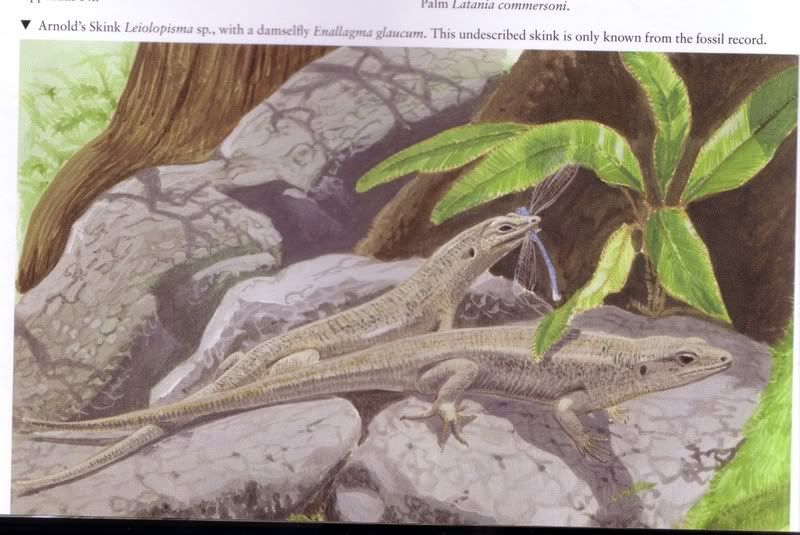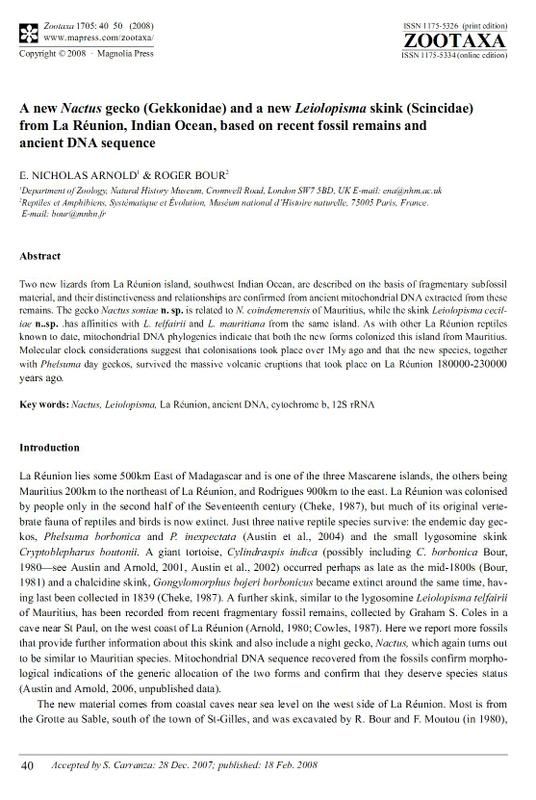Post by another specialist on Sept 3, 2007 8:09:17 GMT
Using ancient and recent DNA to explore relationships of extinct and endangered Leiolopisma skinks (Reptilia: Scincidae) in the Mascarene islands.
Austin JJ, Arnold EN.
Department of Zoology, Natural History Museum, Cromwell Rd., London SW7 5BD, UK.
Phylogenetic analysis, using 1455 bp of recent mtDNA (cytochrome b 714 bp, 12S rRNA 376 bp) and nuclear (c-mos 365 bp) sequence from 42 species and 33 genera of Scincidae, confirms Leiolopisma telfairii, now confined to Round island off Mauritius, is a member of the mainly Australasian Eugongylus group of the Lygosominae. Ancient mtDNA (cytochrome b 307 bp, 12S rRNA 376 bp) was also extracted from subfossils of two other Mascarene taxa that are now extinct: the giant L. mauritiana from Mauritius and Leiolopisma sp., known only from fragmentary remains from Réunion. Sequence divergences of 4.2-5.7% show that all three forms were distinct and form a clade. There is restricted evidence that L. mauritiana and L. sp. from Réunion were sister species. Monophyly and relationships suggest Leiolopisma arose from a single transmarine invasion of the oceanic Mascarene islands from Australasia, 5600-7000 km away. This origin is similar to that of Cryptoblepharus skinks and Nactus geckos in the archipelago but contrasts with Phelsuma day geckos, which appear to have arrived from Madagascar where Mascarene Cylindraspis tortoises may also have originated. Diversification of the known species of Leiolopisma occurred from about 2.3-3.4 Mya, probably beginning on Mauritius with later invasion of Réunion. The initial coloniser may have had a relatively large body-size, but L. mauritiana is likely to have become gigantic within the Mascarenes. Other relationships supported by this investigation include the following. Scincines: Pamelaescincus+Janetaescincus, and Androngo (Amphiglossus, Paracontias). Lygosomines: Sphenomorphus group--(Sphenomorphus, Lipinia (Ctenotus, Anomalopus (Eulamprus and Gnypetoscincus))): Egernia group--Egernia (Cyclodomorphus, Tiliqua); Eugongylus group--(Oligosoma, Bassiana. (Lampropholis (Niveoscincus, Carlia))).
PMID: 16473026 [PubMed - indexed for MEDLINE]
www.ncbi.nlm.nih.gov/sites/entrez?cmd=Retrieve&db=PubMed&list_uids=16473026&dopt=AbstractPlus
Austin JJ, Arnold EN.
Department of Zoology, Natural History Museum, Cromwell Rd., London SW7 5BD, UK.
Phylogenetic analysis, using 1455 bp of recent mtDNA (cytochrome b 714 bp, 12S rRNA 376 bp) and nuclear (c-mos 365 bp) sequence from 42 species and 33 genera of Scincidae, confirms Leiolopisma telfairii, now confined to Round island off Mauritius, is a member of the mainly Australasian Eugongylus group of the Lygosominae. Ancient mtDNA (cytochrome b 307 bp, 12S rRNA 376 bp) was also extracted from subfossils of two other Mascarene taxa that are now extinct: the giant L. mauritiana from Mauritius and Leiolopisma sp., known only from fragmentary remains from Réunion. Sequence divergences of 4.2-5.7% show that all three forms were distinct and form a clade. There is restricted evidence that L. mauritiana and L. sp. from Réunion were sister species. Monophyly and relationships suggest Leiolopisma arose from a single transmarine invasion of the oceanic Mascarene islands from Australasia, 5600-7000 km away. This origin is similar to that of Cryptoblepharus skinks and Nactus geckos in the archipelago but contrasts with Phelsuma day geckos, which appear to have arrived from Madagascar where Mascarene Cylindraspis tortoises may also have originated. Diversification of the known species of Leiolopisma occurred from about 2.3-3.4 Mya, probably beginning on Mauritius with later invasion of Réunion. The initial coloniser may have had a relatively large body-size, but L. mauritiana is likely to have become gigantic within the Mascarenes. Other relationships supported by this investigation include the following. Scincines: Pamelaescincus+Janetaescincus, and Androngo (Amphiglossus, Paracontias). Lygosomines: Sphenomorphus group--(Sphenomorphus, Lipinia (Ctenotus, Anomalopus (Eulamprus and Gnypetoscincus))): Egernia group--Egernia (Cyclodomorphus, Tiliqua); Eugongylus group--(Oligosoma, Bassiana. (Lampropholis (Niveoscincus, Carlia))).
PMID: 16473026 [PubMed - indexed for MEDLINE]
www.ncbi.nlm.nih.gov/sites/entrez?cmd=Retrieve&db=PubMed&list_uids=16473026&dopt=AbstractPlus





